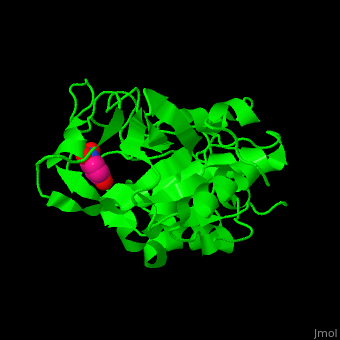Cathepsin
From Proteopedia
(Difference between revisions)
| Line 4: | Line 4: | ||
[[Cathepsin]] (CTS) is a protease which becomes activated at low pH. It is found in lysosomes. Members of the CTS group are denoted as CTSA, CTSB etc and cleave proteins at different peptide bonds. The CTSs are expressed as an inactive precursor pro-CTS (PCTS) which becomes active when a long residue prosegment is cleaved off producing the mature CTS (MCTS).<ref>PMID:15751268</ref> | [[Cathepsin]] (CTS) is a protease which becomes activated at low pH. It is found in lysosomes. Members of the CTS group are denoted as CTSA, CTSB etc and cleave proteins at different peptide bonds. The CTSs are expressed as an inactive precursor pro-CTS (PCTS) which becomes active when a long residue prosegment is cleaved off producing the mature CTS (MCTS).<ref>PMID:15751268</ref> | ||
| - | *CTS B is a cysteine protease.<br /> | + | *'''CTS B, F, H, L, L1, L2''' are cysteine proteases.<br /> |
| - | *CTS | + | *'''CTS D, E''' are aspartyl proteases which degrade insulin.<br /> |
| + | *'''CTS G''' is a serine protease with activity similar to chymotrypsin C.<br /> | ||
| + | *'''CTS K''' is a cysteine protease involved in bone resorption.<br /> | ||
| + | *'''CTS S''' is a cysteine protease involved in degradation of antigenic proteins.<br /> | ||
| + | *'''CTS X''' is a cysteine protease cleaving proteins at their C-terminus.<br /> | ||
==Disease == | ==Disease == | ||
| - | CTS B overexpression is associated with metastatic phenotypes in cancer. CTS C mutations are responsible for the Papillon-Lefevre syndrome. CTS K is involved in osteoporosis. | + | CTS B overexpression is associated with metastatic phenotypes in cancer. CTS C mutations are responsible for the Papillon-Lefevre syndrome. CTS K is involved in osteoporosis. CTS H overexpression is associated with prostate cancer. CTS L1 is implicated in myofibril necrosis. |
== Relevance == | == Relevance == | ||
| - | CTS B breaks down proteins which are involved in amyloid plaques. CTS D is used as a breast cancer marker. | + | CTS B breaks down proteins which are involved in amyloid plaques. CTS D is used as a breast cancer marker. CTS L is a potential drug target in cancer treatment. CTS L2 is expressed by cells of breast and colorectal carcinomas. |
== Structural highlights == | == Structural highlights == | ||
Revision as of 12:06, 23 November 2015
| |||||||||||
3D Structures of Cathepsin
Updated on 23-November-2015
Cathepsin-C mature see Dipeptidyl peptidase-I
References
- ↑ Nomura T, Katunuma N. Involvement of cathepsins in the invasion, metastasis and proliferation of cancer cells. J Med Invest. 2005 Feb;52(1-2):1-9. PMID:15751268

